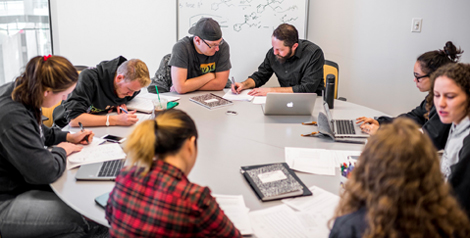Digital Learning Initiatives

Adaptive Courseware
In the summer of 2016, Northern Arizona University was one of eight institutions selected by the Association of Public and Land-Grant Universities (APLU) to participate in a three-year project designed to improve undergraduate education through the use of adaptive courseware. APLU’s grants are funded by the Bill & Melinda Gates Foundation. In addition to NAU, grants were awarded to Arizona State University, Colorado State University, Georgia State University, Oregon State University, Portland State University, University of Louisville, and the University of Mississippi.
Adaptive courseware personalizes learning by dynamically adjusting the path and the pace of content delivery according to the performance of the student. The software moves past areas where the student has achieved mastery and focuses on areas where the student needs to develop a deeper understanding. Such tools can help with the appropriate placement of students into courses for which they are academically prepared to be successful, and can identify areas of weakness that can be remediated while the student is taking the course.
Adaptive courseware doesn’t replace the instructor but can act as an effective diagnostic tool and self-study component of a face-to-face course, and therefore represents a form of blended learning, where some percentage of classroom seat time can be replaced by online work conducted at the student’s personal pace and at the appropriate degree of difficulty.
NAU has begun work on seven of the originally identified fourteen candidate courses and on several others new to our list. The courses come from a broad spectrum across the natural, social, and health sciences as well as the humanities and business. The e-Learning Center (ELC) working with the First Year Learning Initiative (FYLI), a faculty-created program designed to ensure that key lower-division courses are coordinated across sections and utilize evidence-based pedagogy, is redesigning these courses to maintain the coordination and the standards embodied in the FYLI program, while also effectively applying adaptive learning strategies, tools and techniques. For Fall 2017, we anticipate full implementation across all sections of BIO 181, BIO 182, CHM 151, and PSY 240, with selected sections using partial deployment in GLG 112, and PHI 150. In Spring 2018 we will add CHM 152 to the fully deployed list and NTS 135, PHY 262, and PSY 101 to the partial list.
If you’re interested in learning more about adaptive courseware at NAU, contact the e-Learning Center.
Course | Description | Discipline | Deployed | Vendor | Enrolled Annually |
|---|---|---|---|---|---|
BIO 181 | Unity of Life: Cell Life | Biology | Fall 2017 | Learn Smart | 2593 |
BIO 182 | Unity of Life: Multicellular Organisms | Biology | Fall 2017 | Learn Smart | 1304 |
CHM 151 | General Chemistry I | Chemistry | Fall 2017 | ALEKS | 1847 |
CHM 152 | General Chemistry II | Chemistry | Spring 2018 | ALEKS | 981 |
GLG 112 | Geologic Disasters | Geology | Spring 2018 | Smart Sparrow | 1797 |
ISM 120 | Intro to Computer Information Systems | Business | Fall 2017 | Pearson | 1865 |
PHI 150 | Philosophies of the World | Philosophy | Fall 2017 | Smart Sparrow | 772 |
PHY 111 | General Physics I | Physics | Spring 2018 | Pearson | 662 |
PHY 161 | University Physics I | Physics | Spring 2018 | Pearson | 518 |
PHY 262 | University Physics II | Physics | Fall 2017 | Pearson | 520 |
PSY 101 | Introduction to Psychology | Psychology | Spring 2018 | Open | 2331 |
PSY 240 | Developmental Psychology | Psychology | Fall 2017 | Learn Smart | 951 |
NTS 135 | Applied Nutrition and Food Selection | Health Sciences | Spring 2018 | Learn Smart | 216 |
A Definition of Blended Learning
The term blended learning has many definitions and can encompass many forms of course delivery. In the fall of 2013 the Blended Learning Leadership Team (BLLT), a group of faculty who teach using a blended approach met to define what blended learning means on the NAU campus. The BLLT also identified core principles that are found in well-designed blended courses. In addition, the team explicated the role of students and faculty in blended courses.
Examples of effectiveness include
- greater student engagement
- increased student learning
Examples of efficiency include
- reallocation of faculty time toward high-value activities such as research or intensive interaction with students
- differentiated instructional roles, which allow collaborative faculty members to contribute their greatest strengths to courses
- reduced Carnegie seat time
- coordination across multisection courses to eliminate duplication of effort
Roles of faculty and students in blended learning
In successfully blended courses, faculty are expected to
- apply academic rigor
- intentionally design learning activities and assessments that are well aligned with the intended learning outcomes
- create opportunities for students to have meaningful interactions with content, with other students, and with faculty
Students are expected to
- take responsibility for their own learning
- demonstrate appropriate motivation
- participate in active inquiry
Characteristics of successfully blended courses
A blended course has deemed a success when it leads to these results:
- students achieve the intended learning outcomes
- students are actively engaged in the learning process
- classroom interactions are dynamic rather than passive
- face-to-face instruction is carefully integrated with appropriately used technology
- efficiency is achieved